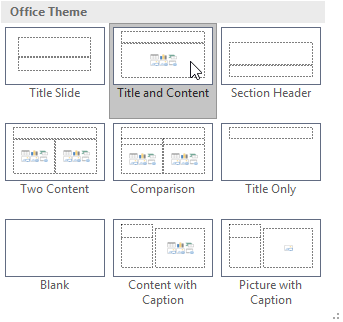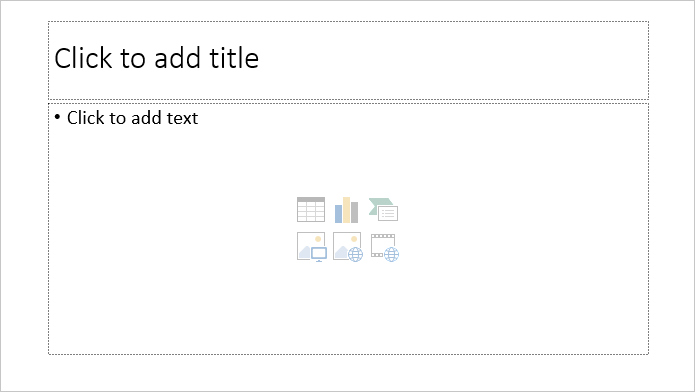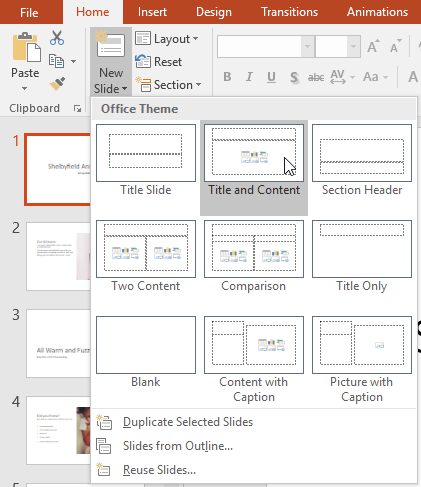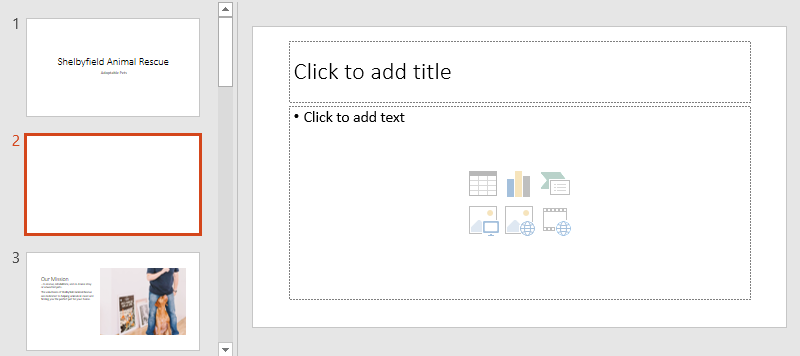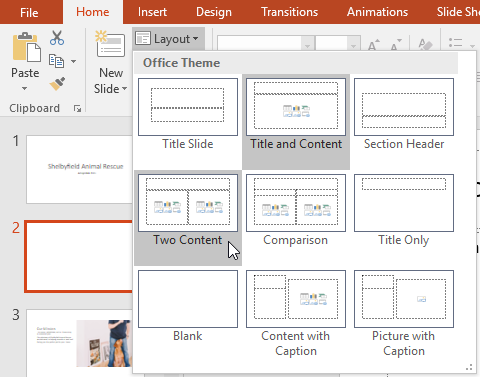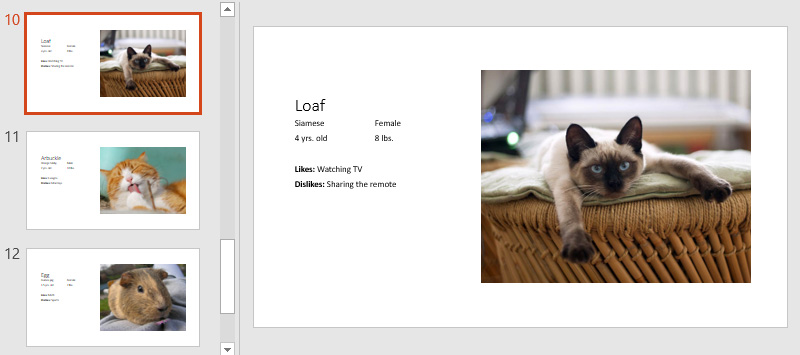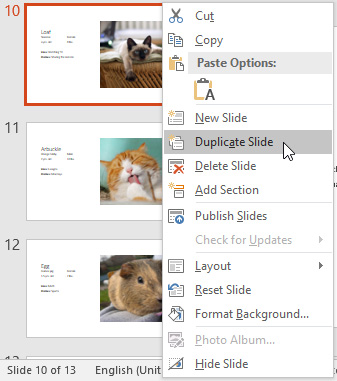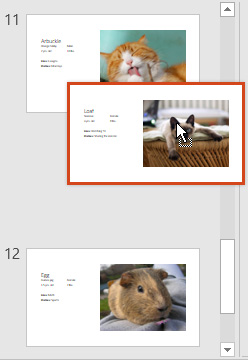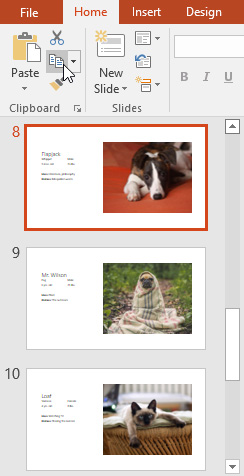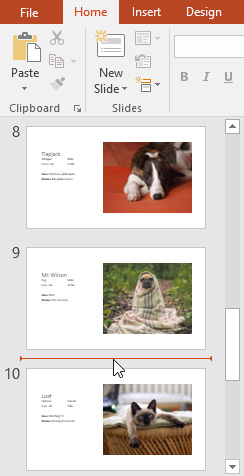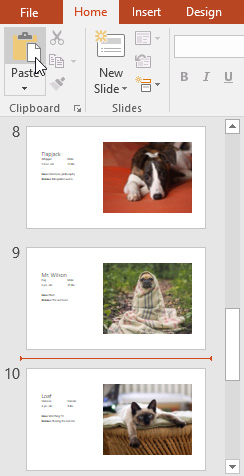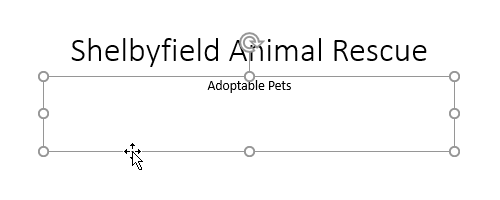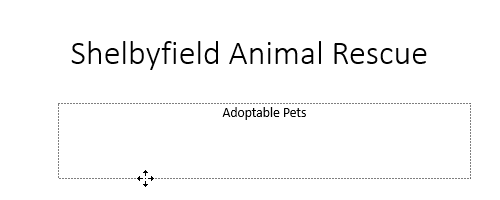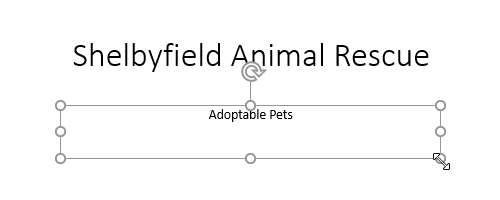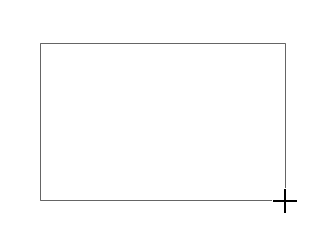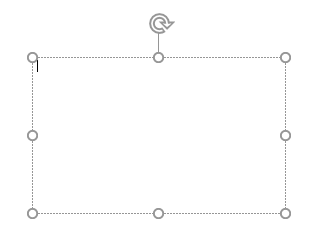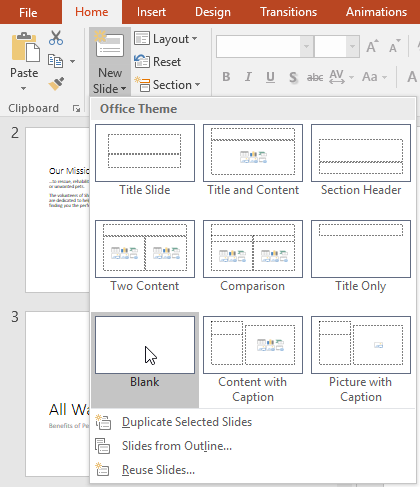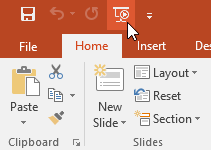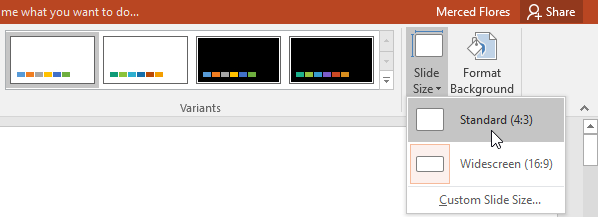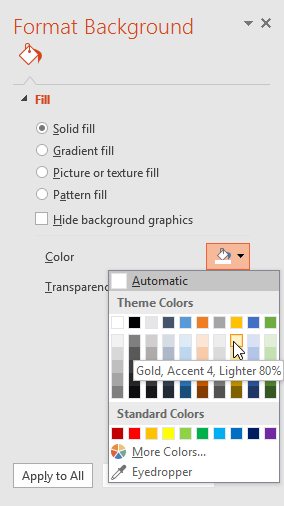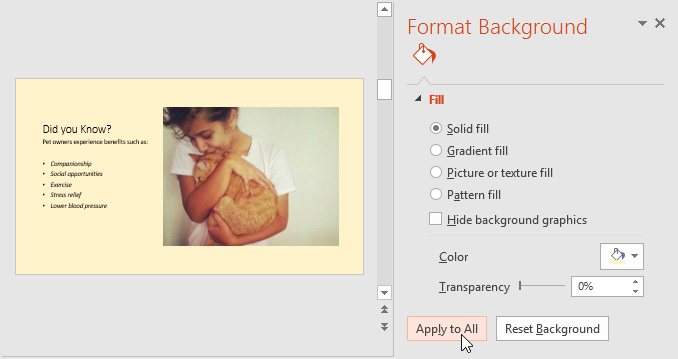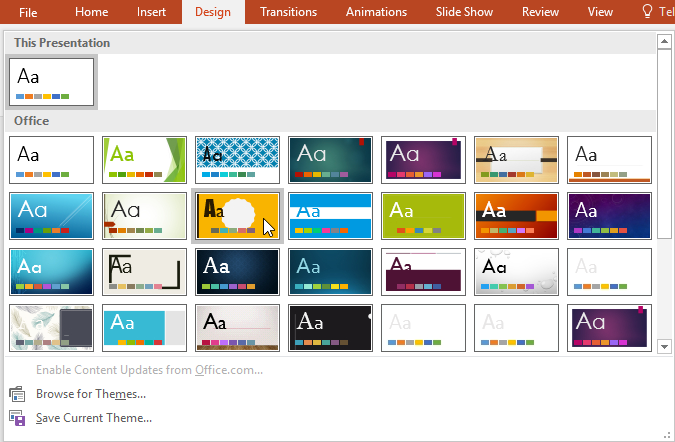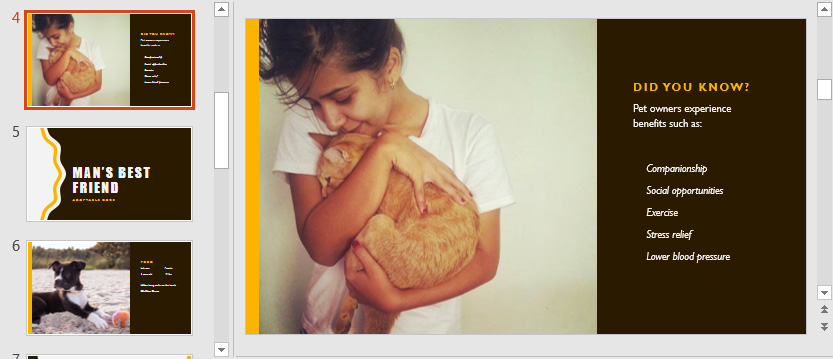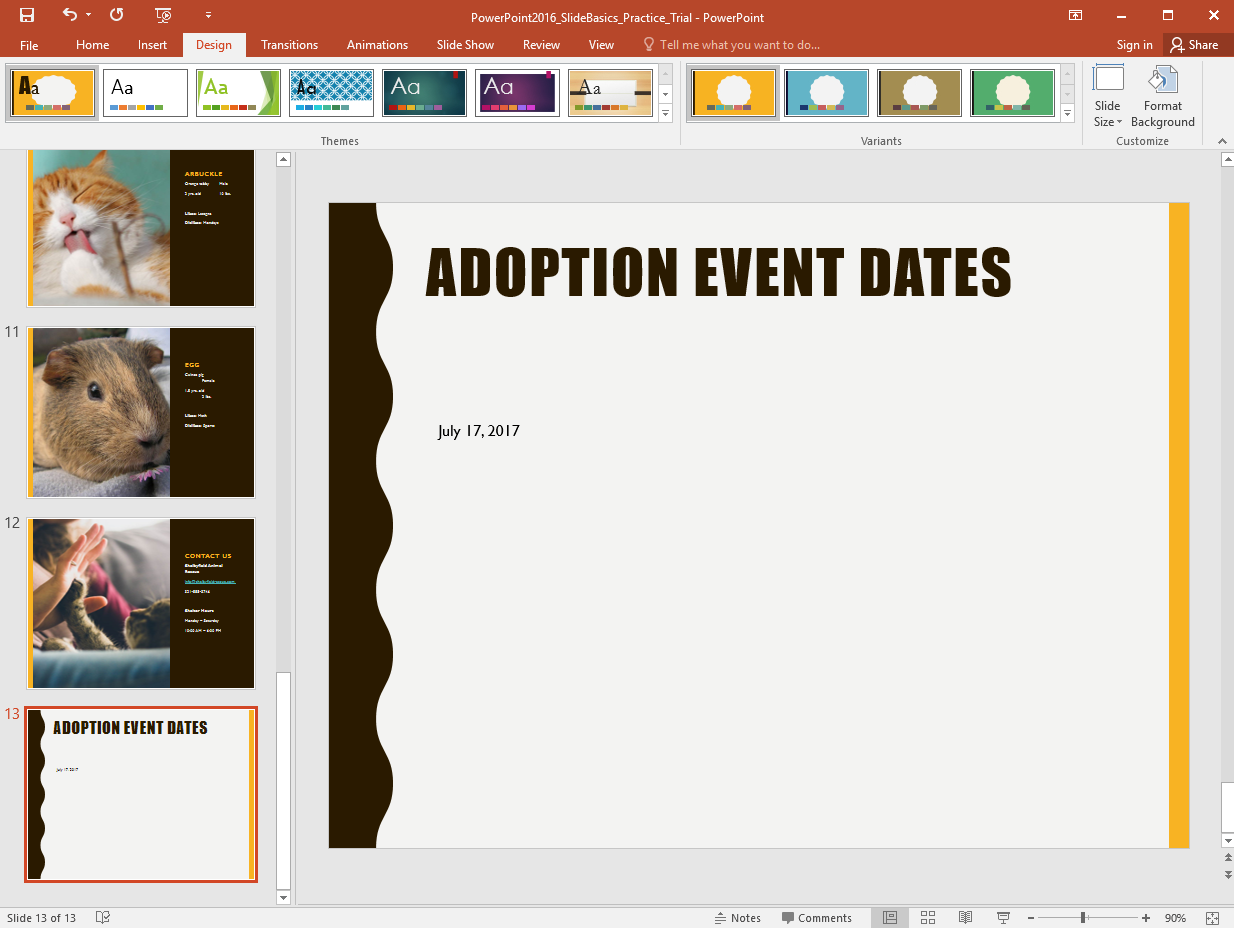/en/powerpoint2016/saving-presentations/content/
Introduction
Every PowerPoint presentation is composed of a series of slides. To begin creating a slide show, you'll need to know the basics of working with slides. You'll need to feel comfortable with tasks such as inserting a new slide, changing the layout of a slide, arranging existing slides, changing the slide view, and adding notes to a slide.
Watch the video below to learn more about slide basics in PowerPoint.
Understanding slides and slide layouts
When you insert a new slide, it will usually have placeholders to show you where content will be placed. Slides have different layouts for placeholders, depending on the type of information you want to include. Whenever you create a new slide, you'll need to choose a slide layout that fits your content.
Placeholders can contain different types of content, including text, images, and videos. Many placeholders have thumbnail icons you can click to add specific types of content. In the example below, the slide has placeholders for the title and content.
To insert a new slide:
Whenever you start a new presentation, it will contain one slide with the Title Slide layout. You can insert as many slides as you need from a variety of layouts.
- From the Home tab, click the bottom half of the New Slide command.
- Choose the desired slide layout from the menu that appears.
- The new slide will appear. Click any placeholder and begin typing to add text. You can also click an icon to add other types of content, such as a picture or a chart.
To change the layout of an existing slide, click the Layout command, then choose the desired layout.
To quickly add a slide that uses the same layout as the selected slide, click the top half of the New Slide command.
Organizing slides
PowerPoint presentations can contain as many slides as you need. The Slide Navigation pane on the left side of the screen makes it easy to organize your slides. From there, you can duplicate, rearrange, and delete slides in your presentation.
Working with slides
- Duplicate slides: If you want to copy and paste a slide quickly, you can duplicate it. To duplicate slides, select the slide you want to duplicate, right-click the mouse, and choose Duplicate Slide from the menu that appears. You can also duplicate multiple slides at once by selecting them first.
- Move slides: It's easy to change the order of your slides. Just click and drag the desired slide in the Slide Navigation pane to the desired position.
- Delete slides: If you want to remove a slide from your presentation, you can delete it. Simply select the slide you want to delete, then press the Delete or Backspace key on your keyboard.
To copy and paste slides:
If you want to create several slides with the same layout, you may find it easier to copy and paste a slide you've already created instead of starting with an empty slide.
- Select the slide you want to copy in the Slide Navigation pane, then click the Copy command on the Home tab. Alternatively, you can press Ctrl+C on your keyboard.
- In the Slide Navigation pane, click just below a slide (or between two slides) to choose a paste location. A horizontal insertion point will appear.
- Click the Paste command on the Home tab. Alternatively, you can press Ctrl+V on your keyboard.
- The slide will appear in the selected location.
Customizing slide layouts
Sometimes you may find that a slide layout doesn't exactly fit your needs. For example, a layout might have too many—or too few—placeholders. You might also want to change how the placeholders are arranged on the slide. Fortunately, PowerPoint makes it easy to adjust slide layouts as needed.
Adjusting placeholders
- To select a placeholder: Hover the mouse over the edge of the placeholder and click (you may need to click the text in the placeholder first to see the border). A selected placeholder will have a solid line instead of a dotted line.
- To move a placeholder: Select the placeholder, then click and drag it to the desired location.
- To resize a placeholder: Select the placeholder you want to resize. Sizing handles will appear. Click and drag the sizing handles until the placeholder is the desired size. You can use the corner sizing handles to change the placeholder's height and width at the same time.
- To delete a placeholder: Select the placeholder you want to delete, then press the Delete or Backspace key on your keyboard.
To add a text box:
Text can be inserted into both placeholders and text boxes. Inserting text boxes allows you to add to the slide layout. Unlike placeholders, text boxes always stay in the same place, even if you change the theme.
- From the Insert tab, select the Text Box command.
- Click and drag to draw the text box on the slide.
- The text box will appear. To add text, simply click the text box and begin typing.
Using blank slides
If you want even more control over your content, you may prefer to use a blank slide, which contains no placeholders. Blank slides can be customized by adding your own text boxes, pictures, charts, and more.
- To insert a blank slide, click the bottom half of the New Slide command, then choose Blank from the menu that appears.
While blank slides offer more flexibility, keep in mind that you won't be able to take advantage of the predesigned layouts included in each theme.
To play the presentation:
Once you've arranged your slides, you may want to play your presentation. This is how you will present your slide show to an audience.
- Click the Start From Beginning command on the Quick Access Toolbar to see your presentation.
- The presentation will appear in full-screen mode.
- You can advance to the next slide by clicking your mouse or pressing the spacebar on your keyboard. Alternatively, you can use the arrow keys on your keyboard to move forward or backward through the presentation.
- Press the Esc key to exit presentation mode.
You can also press the F5 key at the top of your keyboard to start a presentation.
Customizing slides
To change the slide size:
By default, all slides in PowerPoint 2013 use a 16-by-9—or widescreen—aspect ratio. You might know that widescreen TVs also use the 16-by-9 aspect ratio. Widescreen slides will work best with widescreen monitors and projectors. However, if you need your presentation to fit a 4-by-3 screen, it's easy to change the slide size to fit.
- To change the slide size, select the Design tab, then click the Slide Size command. Choose the desired slide size from the menu that appears, or click Custom Slide Size for more options.
To format the slide background:
By default, all slides in your presentation use a white background. It's easy to change the background style for some or all of your slides. Backgrounds can have a solid, gradient, pattern, or picture fill.
- Select the Design tab, then click the Format Background command.
- The Format Background pane will appear on the right. Select the desired fill options. In our example, we'll use a Solid fill with a light gold color.
- The background style of the selected slide will update.
- If you want, you can click Apply to All to apply the same background style to all slides in your presentation.
To apply a theme:
A theme is a predefined combination of colors, fonts, and effects that can quickly change the look and feel of your entire slide show. Different themes also use different slide layouts, which can change the arrangement of your existing placeholders. We'll talk more about themes later in our Applying Themes lesson.
- Select the Design tab on the Ribbon, then click the More drop-down arrow to see all of the available themes.
- Select the desired theme.
- The theme will be applied to your entire presentation.
Try applying a few different themes to your presentation. Some themes will work better than others, depending on your content.
Challenge!
- Open our practice presentation.
- Change the theme of the presentation.
- Delete slide 7. This slide should be blank.
- Add a new slide with the Title and Content layout to the end of the presentation.
- In the Title placeholder, type Adoption Event Dates.
- Select the Content placeholder and delete it.
- Insert a text box and type July 17, 2017, inside it.
- Change the slide size to Standard (4:3). A dialog box will appear asking if you want to maximize or ensure fit. Choose Ensure Fit.
- When you're finished, your presentation should look something like this:
/en/powerpoint2016/text-basics/content/


